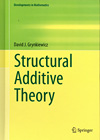- About MAA
- Membership
- MAA Publications
- Periodicals
- Blogs
- MAA Book Series
- MAA Press (an imprint of the AMS)
- MAA Notes
- MAA Reviews
- Mathematical Communication
- Information for Libraries
- Author Resources
- Advertise with MAA
- Meetings
- Competitions
- Programs
- Communities
- MAA Sections
- SIGMAA
- MAA Connect
- Students
- MAA Awards
- Awards Booklets
- Writing Awards
- Teaching Awards
- Service Awards
- Research Awards
- Lecture Awards
- Putnam Competition Individual and Team Winners
- D. E. Shaw Group AMC 8 Awards & Certificates
- Maryam Mirzakhani AMC 10 A Awards & Certificates
- Two Sigma AMC 10 B Awards & Certificates
- Jane Street AMC 12 A Awards & Certificates
- Akamai AMC 12 B Awards & Certificates
- High School Teachers
- News
You are here
Structural Additive Theory

Publisher:
Springer
Publication Date:
2013
Number of Pages:
426
Format:
Hardcover
Series:
Developments in Mathematics 30
Price:
129.00
ISBN:
9783319004150
Category:
Monograph
[Reviewed by , on ]
Mehdi Hassani
02/17/2014
Problems of “additive” nature have been studied in several branches of mathematics, including Additive Number Theory, Additive Combinatorics, and Additive Group Theory. Usually, to deal with such problems, we need to utilize several specific methods and concepts that are common to those areas. Because of the remarkable number of recent results and their applications, it seems that this area can be considered as a new branch of mathematics, entitled “Additive Theory”. This is what the author of the book believes, and also the reason for the title of his impressive book.
The development of Additive Theory has been done by several researchers during last decades, leading to various results connected to Number Theory, Group Theory, and Combinatorics. Despite a noteworthy number of notable results obtained in this area, there have not been many treatments of them as a group, perhaps, because of the feeling that they belong to different branches of mathematics. The book under review attempts a compilation of these results, taking a common point of view, and also considering their overall structure. It is probably the first book to attempt this.
Among a wide range of topics and results, the book contains several recently developed theories that the author puts into Additive Theory, including an entire extended theory of Freiman homomorphisms, a simplified proof of Kemperman’s Structure Theorem, a full presentation of the DeVos-Goddyn-Mohar Theorem with a new proof variation, a unified presentation of the Partition Theorem, the so-called 3k–4 Theorem for distinct integer summands, and the Savchev-Chen Structure result for long zero-sum free sequences. The Combinatorial Nullstellensatz is included along with the recently proved punctured version.
The book is based on undergraduate knowledge from group theory and linear algebra, but it is utterly technical. Indeed, it is written with research savor and contains delicate proofs.
The author has divided the book into three parts. The first part (sumsets) can be used as an introductory course in primary structural sumset theory, and the other two parts (subsequence sums and advanced methods) are useful for students already familiar with basic structural sumset results. The author has added some scrumptious exercises at the end of every chapter, and supplementary notes for interested readers. Moreover, the book has a rich list of selected important references in this area, which shows partially the historical background, as more as, introduces some of the heroes of the field.
Thus, the book can be used as a text at the graduate level, mainly to introduce essential topics of the “Additive Theory”, and to show to students and anybody interested to do to the research in this field, what is going on and what they can do.
Mehdi Hassani is a faculty member at the Department of Mathematics, Zanjan University, Iran. His field of interest is Elementary, Analytic and Probabilistic Number Theory.
See the table of contents in pdf format.
- Log in to post comments




